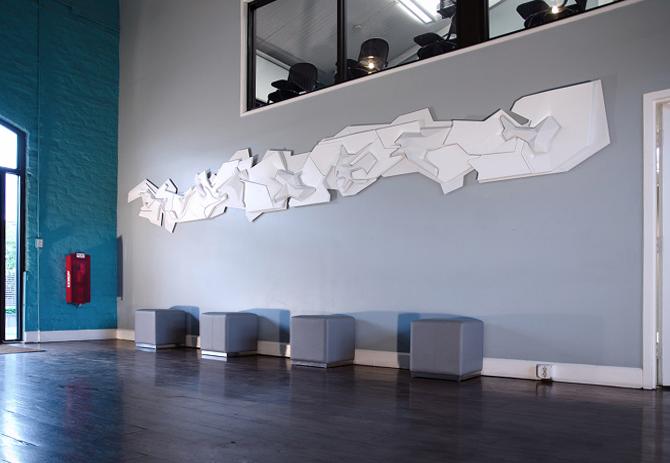wroughten, 2014
wroughten 1
sculptural installation
cnc sculpted foam, plaster, and latex paint
2014
Wroughten
Object Installation, Savannah
Savannah College of art & Design
spring 2014
“She could never bring herself to trim [the fabric] to any pattern; so she shifted and fitted and mused and fitted and shifted them like pieces of a patient puzzle-picture, trying to fit them to a pattern or create a pattern out of them without using her scissors, smoothing her colored scraps with flaccid, putty-colored fingers.” - Gilles Deleuze and Félix Guattari
“Wroughten” refers to the role of the tactile in contemporary form making. Descriptively, the term encompasses that which is carefully formed or worked into shape. Conceptually, “Wroughten” references Adolf Riegl’s study of medieval metalwork and its role in the early history of aesthetic production. Christopher Wood has noted that “Riegl’s model of a universal haptic approach to artifacts was superseded or concealed by a universal optical relationship” (“Riegl’s Mache”, 2004). Consequently, sometime around the Renaissance, a shift occurred that favored a subject-centered view of the world over a discourse relating to the perception and manipulation of objects.
This project denies the authority of the architectural field (continual space of communication), permitting the strange and unexpected interaction of multiple and heterogeneous objects (diverse space of coexistence). This suggests that contemporary aesthetic production is now on an inverse trajectory. In questioning the idea of the subdivided surface in architecture, "Wroughten" reinterprets it as a constellation of objects. This patchy composition does not become a continuous field as Deleuze and Guattari established in, “1440: The Smooth and the Striated” (A Thousand Plateus, 1987); rather, is defined by multiple and distinct boundaries. The resultant 'crazy' configuration is an assortment of discrete objects relating in strange and diverse ways.
The unique expression of form, developed through various 'wrought' techniques (i.e. stuffing, nestling, packing, thickening, etc.), does not obey a single surface logic - is neither smooth nor striated - instead expresses both hard and soft edge. Each object maintains definition of shape by anticipating its neighbor. The relationships between the objects are articulated as a series of tight or loose-fitting joints, adding a level of complexity to their interaction. This kind of composition lacks a certain continuity and predictability.
The objects are arranged on a flat panel with an irregular boundary that is offset from the wall. This un-grounding is vital, because it allows the piece to maintain objecthood, separating itself from the architectural frame from which it is viewed. According to Siegfried Giedion (Mechanization Takes Command, 1948), figure-ground became the fundamental configuration of aesthetic experience when ornament and furnishing began to be incorporated into the wall. To challenge this thinking, the subtle distinction between the panel and the wall works to further deny the legitimacy of architecture as the all-encompassing field.






